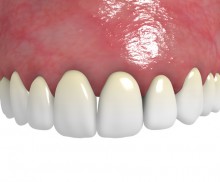Augmentation of soft tissue defects
Oral and dental soft tissue defects can be the result of traumas or surgical ablations that prevalently cause the loss of the original anatomical soft tissue structure. Moreover, soft tissue changes negatively affect the aesthetic appearance and therewith the patient satisfaction. Depending on the size of the defect, tissue deformations can nowadays be aesthetically corrected by a combination of bone and soft tissue augmentation or by soft tissue reconstruction and microsurgical techniques alone [1,2,3]. A soft tissue substitute such as the mucoderm® matrix is an ideal alternative to treat soft tissue defects either in combination with bone grafting materials or in particular situations also for open healing.











